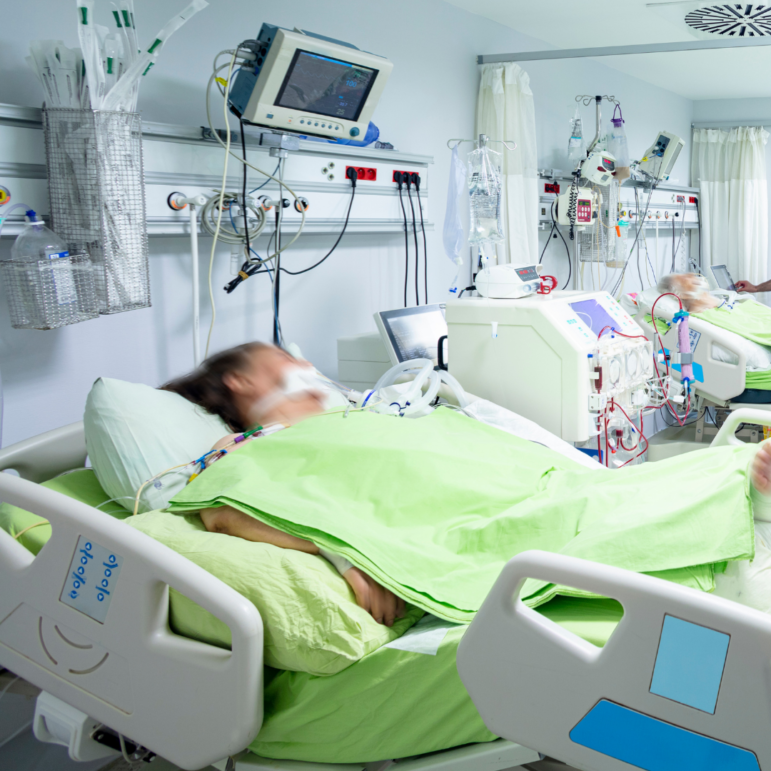After declining for more than a month-and-a-half, the number of COVID-19 patients on ventilators in Pennsylvania has begun to climb again, along with the total number of patients hospitalized with the disease.
Both of those numbers declined sharply in June before plateauing and climbing slowly during July, when the number of new cases in Pennsylvania once again began to increase.
But by August the hospitalization and ventilator-use rates were once again declining steadily, even as some restrictions put in place to stop the spread of the virus were eased.
Pennsylvania Department of Health data shows that the rates began to increase again during the last week of September.

Patients hospitalized with COVID-19 are often placed on ventilators due to breathing difficulties the disease can cause.
Since Sept. 28, when the average number of patients hospitalized for COVID-19 during the preceding two-week period was 452, there has been a 39 percent increase in the average number of patients in the hospital with the disease. On Monday the two-week moving average was 629, Department of Health data shows.
During the same span of time, the average number of patients on ventilators due to COVID-19 has increased 34 percent, according to Pennsylvania Department of Health data. The two-week moving average was 56 patients on ventilators as of Sept. 28, but as of Monday that number had increased to 75.
The statewide totals for these statistics as of Monday, Oct. 12, were:
- 725 patients hospitalized with COVID-19
- 81 COVID-19 patients on ventilators
The state’s COVID-19 dashboard indicates that out of approximately 5,000 available ventilators, roughly 1,100 are currently being used by COVID-19 and other patients.
In Northampton County as of Monday there was one patient hospitalized with COVID-19 and no COVID-19 patients on ventilators, however three county residents have died from the disease so far this month. That’s far fewer than were struck down by it in the spring, when as many as a dozen COVID-19 deaths were reported in a single day by Northampton County officials. However, the deaths attributed to COVID-19 on Oct. 3, Oct. 4 and Oct. 7 come after a period of nearly six weeks when there were no COVID-19 related deaths reported in the county.
The number of COVID-19 patients hospitalized with the disease in Lehigh County has increased nearly 100 percent over the last two weeks, according to Department of Health data, from a two-week rolling average of 20 on Sept. 28 to nearly 40 on Monday. As of Monday there were 55 patients hospitalized with COVID-19 in Lehigh County, five of whom were on ventilators, according to the state dashboard. Ventilator use by COVID-19 patients has increased by about 10 percent in Lehigh County over the past two weeks.
The majority of the patients who are hospitalized with COVID-19 are 65 or older, and most of the deaths that have occurred have been in patients over the age of 65, according to the Pennsylvania Department of Health.
“We know that congregation, especially in college and university settings, yields increased case counts. The mitigation efforts in place now are essential to flattening the curve and saving lives,” Secretary of Health Dr. Rachel Levine said Monday. “Wearing a mask, practicing social distancing and following the requirements set forth in the orders for bars and restaurants, gatherings and telework will help keep our case counts low.”
In Monday’s news release about the 2,254 new cases that were confirmed in Pennsylvania Sunday and Monday, however, the department said it “is seeing significant increases in the number of COVID-19 cases among younger age groups, particularly 19 to 24-year-olds.”
Of the patients who have tested positive to date the age breakdown is as follows:
- Approximately 1 percent are 4 or younger
- Nearly 2 percent are 5-12
- Nearly 5 percent are 13-18
- Nearly 14 percent are 19-24
- Nearly 36 percent are 25-49
- Approximately 21 percent are 50-64
- Approximately 21 percent are 65 or older
With evidence that spread among younger people is what’s driving the infection rate upwards in parts of Pennsylvania, it remains unclear what action the state may take–if any–to halt the uptick in case numbers and infection rates.
As of Monday, Pennsylvania as a whole had a COVID-19 infection rate of 1.12.
The statewide infection rate has not been at that level since early July, according to the website CovidActNow, which classifies rates of infection higher than 1.10 as “high” and “unsustainable.”
Lehigh County’s COVID-19 infection rate as of Monday was 1.15 and Northampton County’s had climbed to 1.28, which is the highest it has been since early April.
An infection rate of 1.4 or higher–meaning that on average each person with COVID-19 is infecting 1.4 other people–would put the county in the “critical” category for COVID infection rates, according to the classification system used by CovidActNow.
As of Monday, two counties in Pennsylvania–Huntingdon and Susquehanna–were reporting infection rates of 1.4 or higher. Northampton County’s rate ranked it fifth in the state for highest infection rates, while Lehigh had the 19th highest infection rate among Pennsylvania’s 67 counties.
In mid-September Northampton County officials reported an infection rate of above 1.10, however it declined to nearly 1.0 before beginning to increase again in late September.
The current predictive trajectory shows it potentially reaching 1.45, although it should be noted that the data which is used to calculate that trajectory could change.
On Monday, St. Luke’s University Health Network announced that in collaboration with community partners, a mobile COVID-19 testing unit known as the CATE Mobile Response Unit will visit various Lehigh Valley locations to conduct COVID-19 testing on-site for individuals who are showing symptoms or who have been exposed to COVID-19.
“Through a shared vision for healthcare equality and a commitment for supporting diverse and underserved communities, the Pennsylvania Department of Health, Highmark Blue Shield, Independence Blue Cross and Latino Connection partnered to create a COVID-19 Mobile Response Unit, CATE, with the unified purpose of building healthy communities through accessibility to knowledge and care,” SLUHN said in a news release. “CATE, which stands for Community-Accessible Testing & Education, focuses on providing testing, education and resources to individuals in low-income, vulnerable communities.”
The unit’s schedule is as follows:
Allentown (flu shots also available) — Bucky Boyle Park, 10 Pump Place, Allentown
• Tuesday, Oct. 13, 11am – 3pm
• Wednesday, Oct. 14, 11am – 3pm
Bethlehem — Marvine Elementary School, 1425 Livingston St., Bethlehem
• Monday, Oct. 26, 10am – 2pm
Bethlehem — Hispanic Center of the Lehigh Valley, 520 E. 4th St., Bethlehem
• Tuesday, Oct. 27, 10am – 2pm
Easton — Easton Neighborhood Center, 902 Philadelphia Road, Easton
• Monday, Nov. 9, 10am – 2pm
• Tuesday, Nov. 10, 10am – 2pm
In addition to St. Luke’s, other community partners supporting the visits include State Rep. Pete Schweyer, Allentown Health Bureau, Bethlehem Health Bureau, Bethlehem Area School District, Hispanic Center Lehigh Valley, Easton Neighborhood Center and Star Wellness.
Individuals interested in receiving services should visit CATEmobileunit.com for more information about upcoming testing locations and dates.
Testing is available on a first come, first served basis. All services are available for insured and uninsured individuals, and social distancing guidelines will be followed at all times.
Symptoms of COVID-19 can include fever, cough, shortness of breath or difficulty breathing, diarrhea, chills, repeating shaking with chills, muscle pain, headache, sore throat and new loss of taste or smell.
Symptoms may appear anywhere from two to 14 days after exposure to the disease, and some people will never develop symptoms after being infected with COVID-19.







